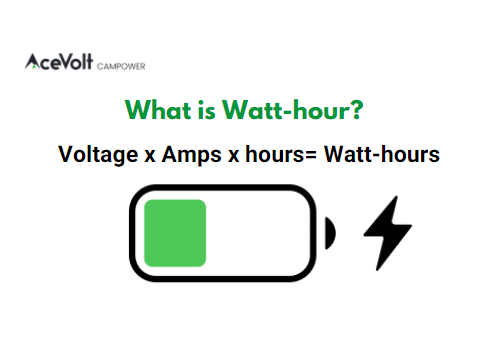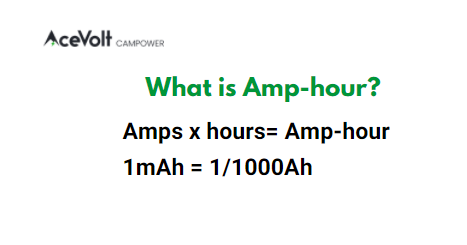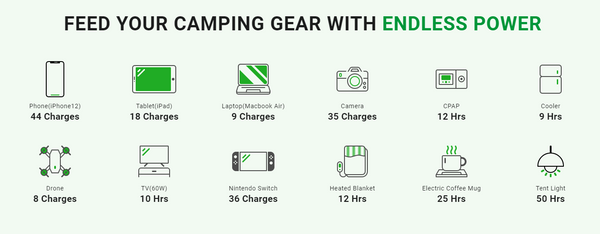
What Is The Battery Capacity Of A Portable Power Station?
A battery is an electrical storage device that stores electricity. It does not make electricity but saves as a store of electricity to be used later. It charges when an AC charger is plugged into it, and it disposes of electricity stored when used. Where a battery is rechargeable, this process repeats over and over. However, the more a process is repeated, the less efficient the battery becomes.
Also, the measurement of electrical energy in batteries is estimated in the real sense and cannot be exactly determined. The lifestyle of a battery determines the type of battery it is.

What is a Watt-hour?
A watt-hour refers to the measure of electrical energy equivalent to power consumption of one watt for one hour. It is the unit of measurement over a period (one hour) of time. Watt-hour, being the measurement, means one watt of average power flow over an hour.
Watt-hour is the unit and pointer to electrical energy. To calculate watts, you have to multiply the components of the electrical energy- volts and amps to get the calculation for watts. So, the formula is Watt-hour= Volts x Amps x hours. The abbreviation for watt-hour is 'wh'.
In a battery, there is electrical energy which means, to calculate the amount of electrical energy in a power source, you have to measure the watts with the watt-hour. So, when we see 33 Watts on a power source, it means that when the volts and amps in the battery were multiplied, they ended up to 33 watts.
What is the battery capacity of a portable power station?
A power station battery capacity varies, but it is common to see a battery capacity of 5,000mAH. This means that where a laptop battery has a 500mAH capacity, it can be charged 10 times. To understand the capacity of the portable power station, where no electric energy is leaking, you should calculate the number of watts on the electrical components you wish to power and then divide it by 500Wh.
The total number of your electrical components falls to 300Wh, it means the portable power station can power them for an hour and thirty minutes.
AA Battery
AA battery is a standard-size single cell cylindrical dry battery. It can be rechargeable or disposable. The AA batteries can only take 1.2-1.5 volts.
According to Wikipedia, Primary (non-rechargeable) zinc-carbon (dry cell) AA batteries have around 400–900mAh capacity. Zinc–carbon batteries are usually marketed as "general purpose" batteries. Zinc-chloride batteries store about 1000 to 1500 mAh are often sold as "heavy-duty" or "super heavy duty." Alkaline batteries from 1700 mAh to 2850 mAh cost more than zinc-chloride batteries but hold an additional charge. Lithium-ion phosphate batteries have a capacity of 2800mAh and above.
It is suggested that the power station battery used should be the LiFePO4 AA battery because it can give off a strong energy surge after its usage for a long time. They are batteries with the low-temperature operation. Perhaps, you may ask, 'Is A Portable Power Station Worth The Investment? ', check out this buying guide before you make a purchase.
Advantages of LiFePo4 Batteries
-
Longer Life Cycle
This battery has a longer life cycle than other batteries as it has 1,000-10,000 cyrongcles. It is mildly affected or degraded by high temperatures. This means that it is more durable and cost-effective than the other battery types because, while the other battery types are replaced within a short time, the lithium-ion batteries still have a long time in their life cycle.
-
It does not cause environmental hazards does disposal
Safety during disposal is one major concern for batteries because of acid, lead, and alkaline used in most batteries. However, a lithium-ion phosphate battery has non-toxic components and does not affect the environment and humans adversely.
-
Low Combustibility
Lithium-ion phosphate batteries have a phosphate cathode which makes them incombustible and stable during overheating and overcharging. It has thermal and chemical stability and does not change temperature even when the device attached is higher.
-
Minimal Leakage risk
It has a minimal leak risk, and you are sure that it is not hazardous to the environment and yourself.

What is the meaning of Ah in battery?
While electricity is measured in Wh, battery capacity is measured in Ah, which is amp-hours. This refers to the number of amps the battery can deliver in an hour.
A mAh means the one-thousandth of an ampere-hour, and it is the technical term for how much electrical charge a particular battery holds. That is the symbol for milliampere/hour. A mAh to Ah conversion is one-thousandth, which means that for every 1 Ah, there is a 1000 mAh.
To explain further, mAh refers to the amount of electrical charge a battery can hold at a time. It is the maximum charge you can get from a battery. In the case of a portable power bank, the battery capacity is 5,000mAh, which means that it has a high power capacity and can take in and give out large amounts of power.

How long will a portable power station last?
This is dependent on many factors such as the battery's age, type of battery, size, and the number of electronics used with the power station. Where the battery is old, it does not have its capacity again and cannot last as long as it was new. The type of battery also depends as there are quality batteries that would last as long as it was written on it, while others would not last as much.
The number of electronics used with the power station determines the rate and discharge of energy from the power station to the electronics. Use AceVolt Campower700 solar panel battery generator as an example, you can charge an iPhone 12 for 44 times per charge of a power station.
How long does it take to recharge a portable power station?
It depends on the amount of Watts coming in from the power source into the battery. Where the amount is faster, the power station charges faster. Assuming a power station takes 500Wh to be fully charged, and the power source gives 30W, it will take over 16 hours to charge the battery fully.
It is necessary to examine the AC's battery capacity and the power source's capacity to ensure you charge the battery with a fast power source and clean electrical energy.
Conclusion
It is important to know the capacity of the power station that would provide effective power in your preferred location before buying the power station. This will help you put in perspective the amount of electricity it will need to charge the power station and the amount of time the power station can fully power your location.
1 comment
Related Product























Also keep in mind, to full discharge before recharging, otherwise the battery will stay at a point where it will not be fully charged giving you less each time.
Leave a comment